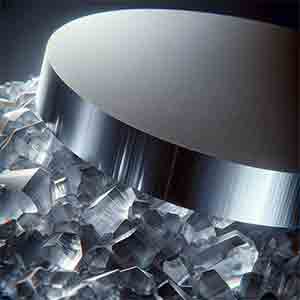SoQ to Research Metasurfaces
A postdoc requested a quote for the following:
We are a University Science and Technology Research Group, and are looking for a SOQ (Silicon on quartz) wafer that can realise Si structures etched on both sides of SiO2, where the thickness of the quartz layer is 1.5mm and the thickness of the Si layer is 1μm, are there any such wafers and if not can they be customised.
We don't have specific requirements for the size of the wafers, the specification is 1mm thick quartz layer with 1μm thick amorphous or monocrystalline silicon on both its front and back sides. Before giving the specific quantity, we would like to first determine whether this SOQ wafer can be customised, because the quartz layer is thicker while the device layers on both sides are thinner. Then we would like to know the lead time for this customised wafers.
What we are actually doing is related to metasurfaces. For hypersurfaces, the height of the dielectric column is a very important parameter, because for a fixed refractive index of the dielectric, it is necessary to have an appropriate height to cover the entire 2π phase distribution, which can be used in the design of the metasurface to achieve the modulation of the light, that is why I mentioned in the previous email that I want the thickness of the single crystal silicon or amorphous silicon layer to be at 1μm, and this is the height of the unit that we have set in the design. And I need to modify the thickness of the quartz layer that I mentioned before, it needs to be 1.5mm. I know this kind of wafer is not very common, so I wonder if I can ask you to confirm whether this kind of wafer can be customised and prepared individually. If so, I would also like to know the required delivery time and price, and if it is difficult to realize, I hope you can let me know.
Reference # 277397 for specs and prcing.
Get Your Quote FAST! Or, Buy Online and Start Researching Today!
What is Silicon-on-Quartz?
Silicon on quartz (SoQ) refers to a type of technology where a thin layer of silicon is deposited or grown on a  quartz substrate. Quartz, being a form of silicon dioxide (SiO2), is an excellent insulator and has superior optical properties, while silicon is a semiconductor widely used in the electronics industry.
quartz substrate. Quartz, being a form of silicon dioxide (SiO2), is an excellent insulator and has superior optical properties, while silicon is a semiconductor widely used in the electronics industry.
The combination of silicon on quartz offers several advantages:
-
High-Quality Silicon Layer: The silicon layer can be of very high purity and quality, which is essential for electronic and photonic applications.
-
Thermal Stability: Quartz has a high melting point and excellent thermal stability, making the SoQ structure suitable for high-temperature applications.
-
Optical Properties: Quartz is transparent to a wide range of wavelengths, including the ultraviolet and infrared regions. Because quartz is transparent to ultraviolet and infrared light, it is very useful for optoelectronic devices like sensors that need to detect a wide range of wavelengths.
-
Low Electrical Loss: The insulating properties of quartz mean that SoQ structures can have very low electrical loss, which is important for high-frequency electronic applications.
-
Mechanical Strength: Quartz substrates are mechanically strong and resistant to wear, which can be beneficial in certain applications.
SoQ tech is the backbone of cutting-edge stuff like high-end electronics, light-driven devices, sensing gadgets and tiny mechanical systems. Because silicon on quartz has useful electrical, optical, and mechanical properties, it is very handy for making high-tech stuff like advanced electronics and tiny mechanical systems.
A metasurface is a two-dimensional material designed to manipulate electromagnetic waves, such as light, in ways that natural materials cannot. Unlike traditional materials, which interact with light based on their bulk properties, metasurfaces achieve their effects through their structure, which is often composed of an array of tiny, precisely arranged elements called "meta-atoms."
These meta-atoms can be engineered to control various properties of light, including its phase, amplitude, and polarization. This allows metasurfaces to perform a variety of optical functions, such as focusing light, bending it at unusual angles, and even creating holograms, all with a much thinner and lighter form factor compared to conventional lenses or mirrors.
Metasurfaces are used in a range of applications, including advanced imaging systems, telecommunications, and potentially even in invisibility cloaks. Their ability to manipulate light at a very fine scale opens up new possibilities in photonics and other fields where controlling light is essential.
